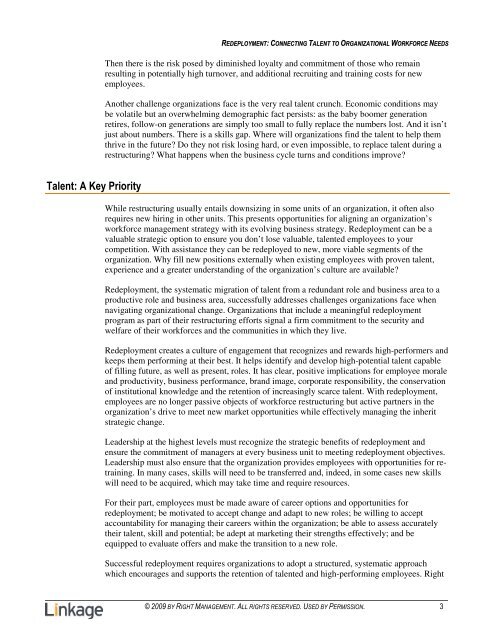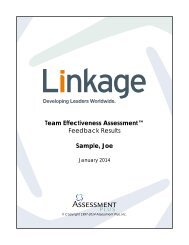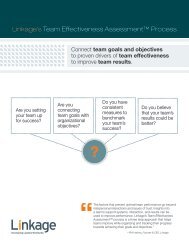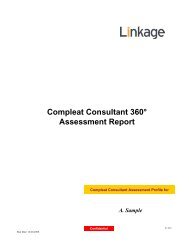Redeployment: Connecting Talent to Organizational Workforce Needs
Redeployment: Connecting Talent to Organizational Workforce Needs
Redeployment: Connecting Talent to Organizational Workforce Needs
Create successful ePaper yourself
Turn your PDF publications into a flip-book with our unique Google optimized e-Paper software.
REDEPLOYMENT: CONNECTING TALENT TO ORGANIZATIONAL WORKFORCE NEEDS<br />
Then there is the risk posed by diminished loyalty and commitment of those who remain<br />
resulting in potentially high turnover, and additional recruiting and training costs for new<br />
employees.<br />
Another challenge organizations face is the very real talent crunch. Economic conditions may<br />
be volatile but an overwhelming demographic fact persists: as the baby boomer generation<br />
retires, follow-on generations are simply <strong>to</strong>o small <strong>to</strong> fully replace the numbers lost. And it isn’t<br />
just about numbers. There is a skills gap. Where will organizations find the talent <strong>to</strong> help them<br />
thrive in the future Do they not risk losing hard, or even impossible, <strong>to</strong> replace talent during a<br />
restructuring What happens when the business cycle turns and conditions improve<br />
<strong>Talent</strong>: A Key Priority<br />
While restructuring usually entails downsizing in some units of an organization, it often also<br />
requires new hiring in other units. This presents opportunities for aligning an organization’s<br />
workforce management strategy with its evolving business strategy. <strong>Redeployment</strong> can be a<br />
valuable strategic option <strong>to</strong> ensure you don’t lose valuable, talented employees <strong>to</strong> your<br />
competition. With assistance they can be redeployed <strong>to</strong> new, more viable segments of the<br />
organization. Why fill new positions externally when existing employees with proven talent,<br />
experience and a greater understanding of the organization’s culture are available<br />
<strong>Redeployment</strong>, the systematic migration of talent from a redundant role and business area <strong>to</strong> a<br />
productive role and business area, successfully addresses challenges organizations face when<br />
navigating organizational change. Organizations that include a meaningful redeployment<br />
program as part of their restructuring efforts signal a firm commitment <strong>to</strong> the security and<br />
welfare of their workforces and the communities in which they live.<br />
<strong>Redeployment</strong> creates a culture of engagement that recognizes and rewards high-performers and<br />
keeps them performing at their best. It helps identify and develop high-potential talent capable<br />
of filling future, as well as present, roles. It has clear, positive implications for employee morale<br />
and productivity, business performance, brand image, corporate responsibility, the conservation<br />
of institutional knowledge and the retention of increasingly scarce talent. With redeployment,<br />
employees are no longer passive objects of workforce restructuring but active partners in the<br />
organization’s drive <strong>to</strong> meet new market opportunities while effectively managing the inherit<br />
strategic change.<br />
Leadership at the highest levels must recognize the strategic benefits of redeployment and<br />
ensure the commitment of managers at every business unit <strong>to</strong> meeting redeployment objectives.<br />
Leadership must also ensure that the organization provides employees with opportunities for retraining.<br />
In many cases, skills will need <strong>to</strong> be transferred and, indeed, in some cases new skills<br />
will need <strong>to</strong> be acquired, which may take time and require resources.<br />
For their part, employees must be made aware of career options and opportunities for<br />
redeployment; be motivated <strong>to</strong> accept change and adapt <strong>to</strong> new roles; be willing <strong>to</strong> accept<br />
accountability for managing their careers within the organization; be able <strong>to</strong> assess accurately<br />
their talent, skill and potential; be adept at marketing their strengths effectively; and be<br />
equipped <strong>to</strong> evaluate offers and make the transition <strong>to</strong> a new role.<br />
Successful redeployment requires organizations <strong>to</strong> adopt a structured, systematic approach<br />
which encourages and supports the retention of talented and high-performing employees. Right<br />
© 2009 BY RIGHT MANAGEMENT. ALL RIGHTS RESERVED. USED BY PERMISSION. 3
















